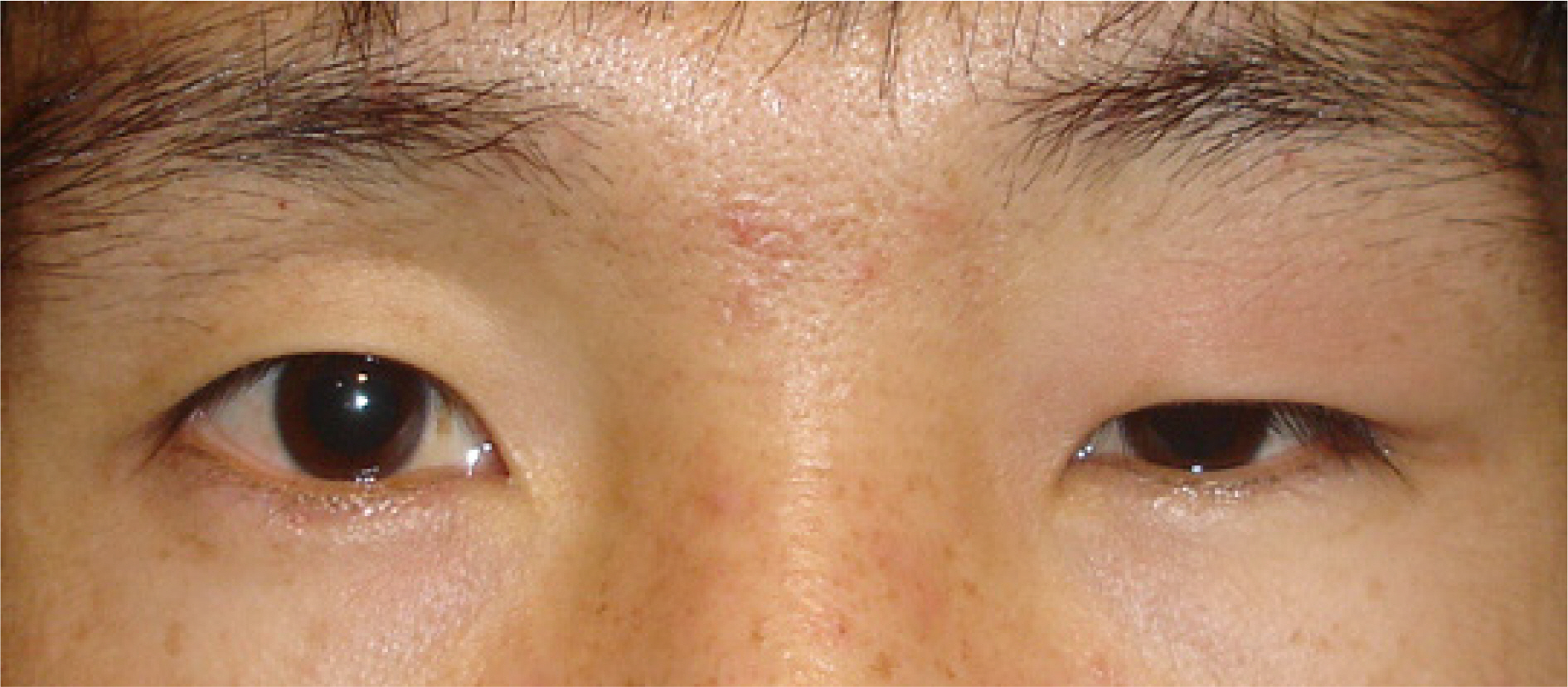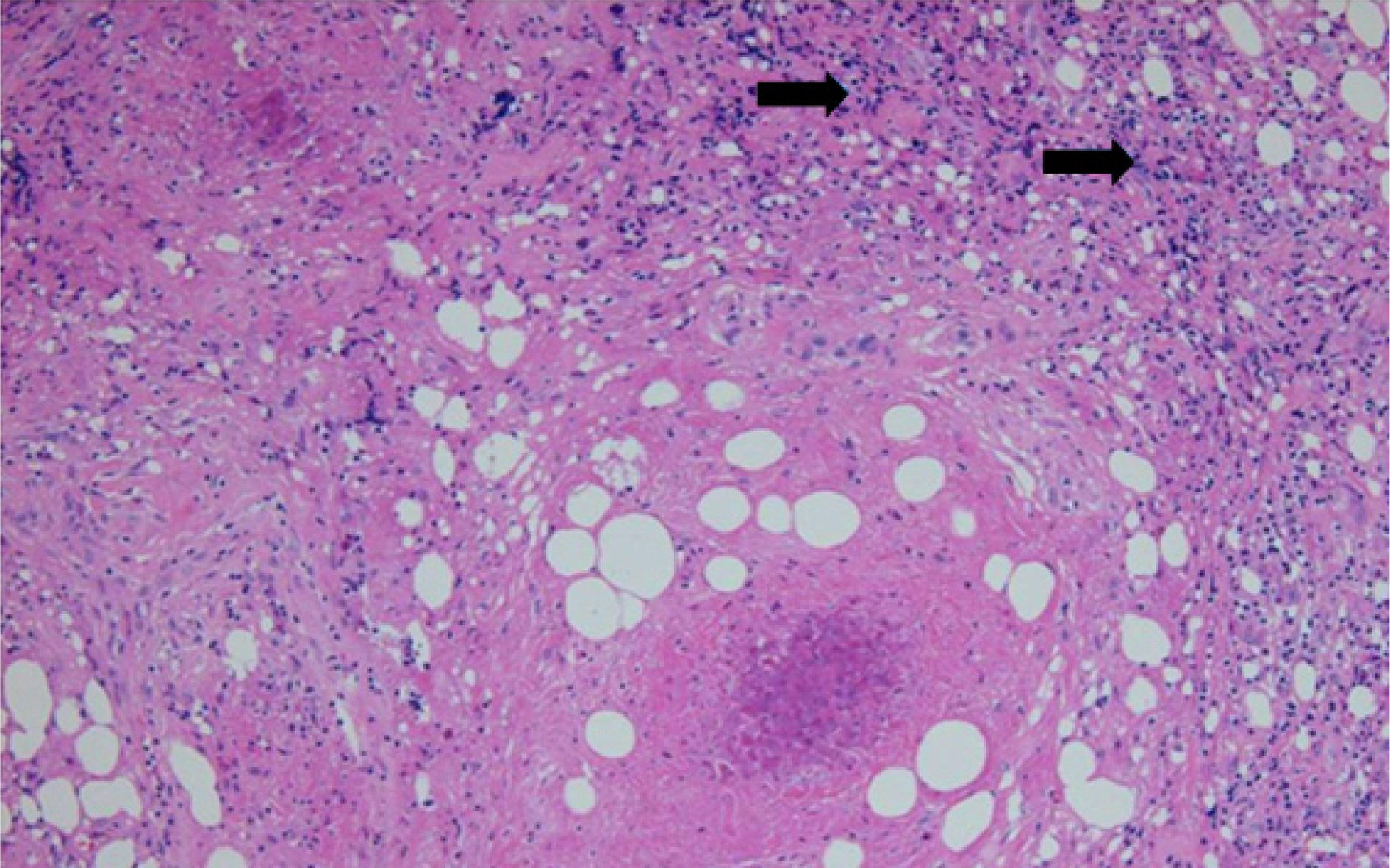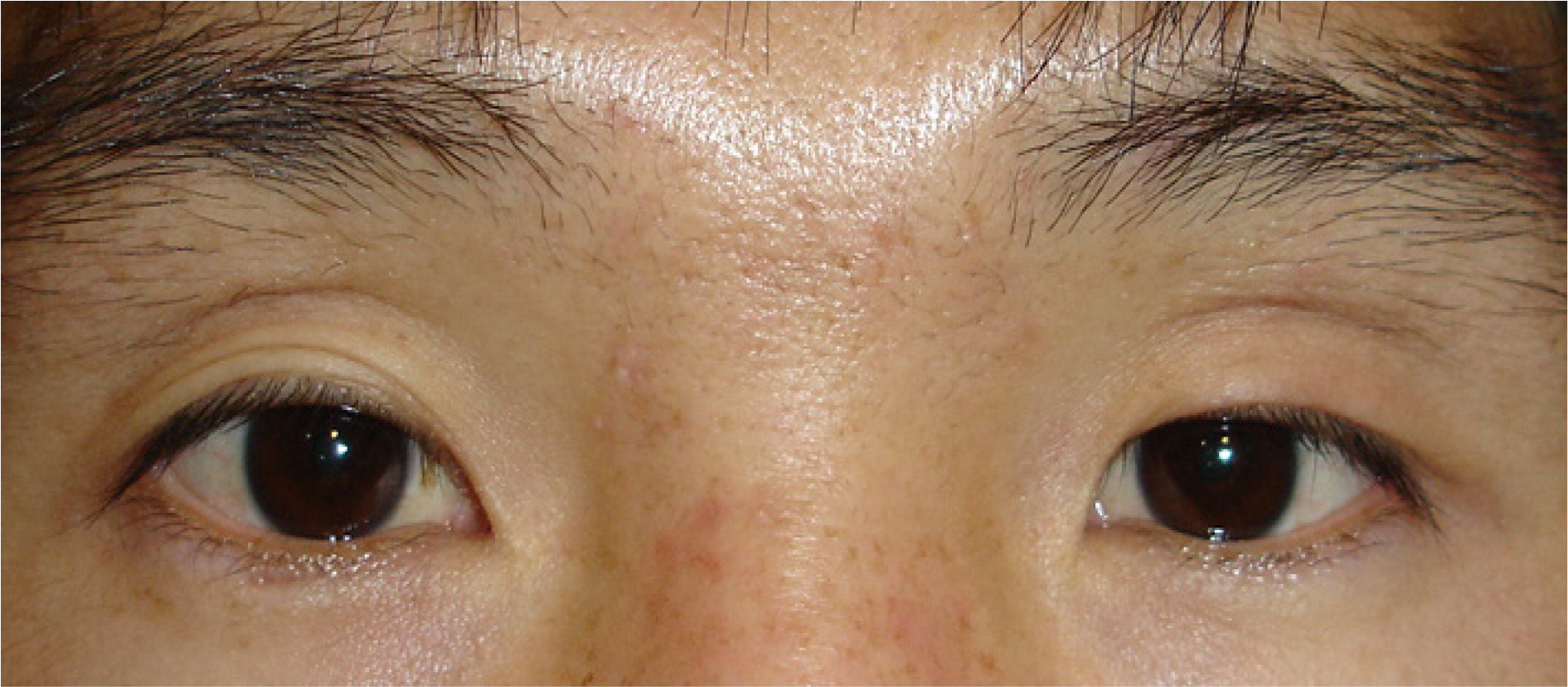J Korean Ophthalmol Soc.
2008 Apr;49(4):677-680. 10.3341/jkos.2008.49.4.677.
A Case of Post-traumatic Necrobiotic Xanthogranuloma of the Orbit
- Affiliations
-
- 1National Health Insurance Corporation Ilsan Hospital, Gyeonggi, Korea. khyeye@hanmail.net
- KMID: 2211502
- DOI: http://doi.org/10.3341/jkos.2008.49.4.677
Abstract
-
PURPOSE: To investigate the role of nitric oxide (NO) on the migration of cultured human Tenon's capsule
PURPOSE: Necrobiotic xanthogranuloma is a very rare disease characterized by the presence of yellow subcutaneous skin lesions and systemic paraproteinemia. We report a case of post traumatic necrobiotic xanthograuloma that presented with a preseptal mass.
CASE SUMMARY
A 31-year-old man presented with ptosis and a mass on the left superior orbit that developed after trauma 3 weeks prior to admission. A computed tomography scan showed a contrast-enhancing preseptal mass, and surgical exploration was performed.
CONCLUSIONS
Histopathological examination revealed a tumor that had all the major features of necrobiotic xanthogranuloma, including fat necrosis with granulomatous inflammation, giant multinucleated cells, foamy cells, and several lymphoid follicles with germinal centers. Hematologic evaluation revealed polyclonal gammopathy.
MeSH Terms
Figure
Cited by 2 articles
-
Adult Orbital Xanthogranulomatous Disease in a 42-Year-Old Woman
Seok Joong Chung, Helen Lew
J Korean Ophthalmol Soc. 2011;52(8):975-978. doi: 10.3341/jkos.2011.52.8.975.Adult-Onset Asthma and Periocular Xanthogranuloma in a 75-Year-Old Man
Seung Wan Nam, Ju-Hyang Lee, Kyung In Woo, Yoon-Duck Kim
J Korean Ophthalmol Soc. 2016;57(9):1465-1471. doi: 10.3341/jkos.2016.57.9.1465.
Reference
-
References
1. Mehregan DA, Winkelmann RK. Necrobiotic xanthogranuloma. Arch Dermatol. 1992; 128:94–100.
Article2. Kossard S, Winkelmann RK. Necrobiotic xanthogranuloma with paraproteinemia. J Am Acad Dermatol. 1980; 3:257–70.
Article3. Winkelmann RK, Dahl PM, Perniciaro C. Asteroid and other cytoplasmic inclusions in necrobiotic xanthogranuloma with paraproteinemia. J Am Acad Dermatol. 1998; 38:967–70.4. Novak PM, Robins TO, Winkelmann RK. Necrobiotic xanthogranuloma with myocardial and nodular transformation of the liver. Hum Pathol. 1995; 23:195–6.5. Umbert I, Winkelmann RK. Necrobiotic xanthogranuloma with cardiac involvement. Br J Dermatol. 1995; 133:438–43.
Article6. Finan MC, Winkelmann RK. Necrobiotic xanthogranuloma with paraproteinaemia: a review of 22 cases. Medicine. 1986; 65:376–87.7. Chave TA, Chowdhury MM, Holt PJ. Recalcitrant necrobiotic xanthogranuloma responding to pulsed highdose oral dexamethasone plus maintenance therapy with oral prednisolone. Br J Dermatol. 2001; 144:158–61.
Article8. Venencie PY, Le Bras P, Toan ND, et al. Recombinant interferon alfa‐2b treatment of necrobiotic xanthogranuloma with paraproteinemia. J Am Acad Dermatol. 1995; 32:666–7.
Article9. Finelli LG, Ratz JL. Plasmapheresis, a treatment modality for necrobiotic xanthogranuloma. J Am Acad Dermatol. 1987; 17:351–4.
Article10. Sivak Callcott JA, Rootman J, Rasmussen SL, et al. Adult xanthogranulomatous disease of the orbit and ocular adnexa: new immunohistochemical findings and clinical review. Br J Ophthalmol. 2006; 90:602–8.11. Ugurlu S, Bartley GB, Gibson LE. Necrobiotic xanthogranuloma: Long‐ term outcome of ocular and systemic involvement. Am J Ophthalmol. 2000; 129:651–7.12. Bullock JD, Bartley GB, Campbell RJ, et al. Necrobiotic xanthogranuloma with paraproteinemia. Case report and a pathogenetic theory. Ophthalmology. 1986; 93:1233–6.13. Char DH, Leboit PE, Ljung BM, Wara W. Radiation therapy for ocular necrobiotic xanthogranuloma. Arch Ophthalmol. 1987; 105:174–5.
Article14. Rappersberger K, Wrba F, Heinz R, et al. Necrobiotic xanthogranuloma in paraproteinemia. Hautarzt. 1989; 40:358–63.15. Stork J, Kodetova D, Vosmik F, Krejca M. Necrobiotic xanthogranuloma presenting as a solitary tumor. Am J Dermatopathol. 2000; 22:453–6.
- Full Text Links
- Actions
-
Cited
- CITED
-
- Close
- Share
- Similar articles
-
- Necrobiotic Xanthogranuloma with Multiple Myeloma and No Periorbital Involvement
- Necrobiotic Xanthogranuloma with Monoclonal Gammopathy
- Necrobiotic Xanthogranuloma with Paraproteinemia: A case report
- A Case of Pedunculated Xanthogranuloma in the Upper Eyelid Margin of an Adult
- Primary Necrobiotic Xanthogranulomatous Sialadenitis with Submandibular Gland Localization without Skin Involvement





